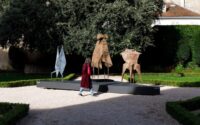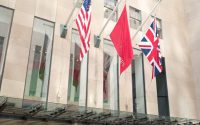An Artist-Made Billboard in Times Square has a Hidden Message: Save Gaza
In August, LG Art Lab approached artist Patrick Amadon with a seemingly simple request: Contribute the inaugural artwork for the public launch of its blockchain-backed online art market. A sweet deal for exposure; the work would screen on 14 million smart screens and one monumental billboard in Times Square, New York. But the artist, who just goes by Amadon, thought, ‘sure, but are you sure?’
A cursory Google search of his practice reveals a dedication to dissent: His work—glitchy frames of mundane imagery made hostile—excavates issues of surveillance, media literacy, news propaganda, and artists’ rights. He’s barred, at threat of prison, from China and its territories for sneaking support for pro-democracy protests into a digital canvas displayed on a department store in Hong Kong last year.
It should perhaps be unsurprising, then, that his LG commission, titled Passive Observer and taking up a few stories of Times Square, has a secret unbeknownst to its benefactors: The Wikipedia page for “Gaza genocide.” The page appears between frames of blinking eyes, like death watched from a distance, then buried by scrolling hands.
“Everyone’s watching what’s happening to Palestinian civilians, watching the world unfold, but no one is doing anything,” Amadon told ARTnews. “It’s incredibly tough to achieve change as an individual, but as an artist with an avenue to get a message out, that’s a nice opportunity.”
The health ministry in Gaza reported that at least 40,861 people have been killed and 94,398 wounded in Gaza by Israel Defense Forces since the Hamas attack on October 7, 2023. More than 2.1 million people in Gaza—nearly the entirety of its population—face “imminent famine,” the Integrated Food Security Phase Classification, an joint effort of UN agencies and international aid groups, reported in June.
In January of this year, the International Court of Justice (ICJ) ordered Israel to take steps to ensure acts of genocide, as defined in the Convention on the Prevention and Punishment of the Crime of Genocide, were not committed by its forces in Gaza. The court did not rule that Israel was committing genocide, but did declare its legal right to proceed with the genocide case brought by South Africa. Israel and the United States have rejected all accusations of genocidal intent.
The art world—a broad ecosystem of galleries, museums, and the artists, collectors and curators within—has struggled to navigate the morally divisive war. Accusations of censorship have roiled cultural institutions in the US and Europe, and in New York City, major museums continue to unwillingly serve as the site of pro-Palestine demonstrations.
Asked if he was wary of reprisal for his own guerilla protest, Amadon, having overcome the controversy in China, said he was mostly unconcerned.
The Hong Kong work, called No Rioters, quietly displayed the names of individuals imprisoned for protesting the 2020 national security law that expanded Beijing’s influence over Hong Kong. The legislation has been heavily criticized for criminalizing a broad range of dissenting acts under secession, effectively stifling freedom of expression in the administrative region. In July 2023, Hong Kong authorities reported that at least 200 anti-Beijing demonstrators had been arrested and roughly half charged.
“With [these projects], security is a concern. The gallery I worked with had me sign a contract saying they didn’t know what I had planned. My computer caught some expensive malware,” he said, adding that the Hong Kong exile community, however, appreciated the gesture.
“That’s what this is about, I think. An act of solidarity.”



